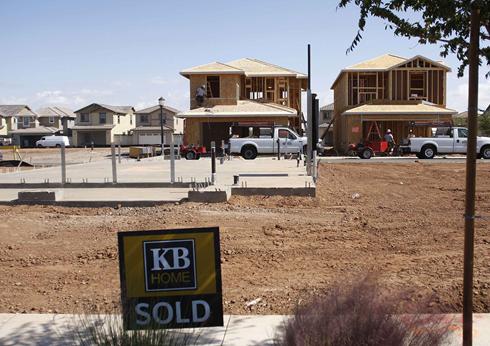Home buyers are focusing on smaller homes
Stephanie Armour
USA Today

KB Home is building smaller homes nationwide. Here, a sold sign sits in front of homes being built in Gilbert, Ariz. By Photos by Joshua Lott, Reuters
Out of the depths of housing’s worst downturn, smaller new homes are turning into a bright spot for some home builders.
The trend toward more compact new homes is being driven partly by the fact that more customers are first-time buyers who have less to spend.
Home builders are responding by offering smaller designs with features such as high ceilings and large windows that create a spacious feel and options that let buyers personalize the model they choose.
KB Home‘s smaller model helped it achieve a 62% increase in year-over-year net orders in the third quarter.
The trend cuts across the industry. The median square footage of new homes has dropped 9% from a peak of 2,300 square feet in the third quarter of 2006 to 2,100 square feet in the July-September period this year, according to data from the National Association of Home Builders (NAHB).
Housing size drops with each recession, but economists expect the current movement toward smaller homes to continue for some time in part because of the severity of the current housing market slump.
First-time buyers are driving the trend toward smaller homes because that is what they can afford, says David Crowe, chief economist at the NAHB.
As the economy improves, move-up buyers generally enter the market and begin buying larger homes. But this time, so many homeowners owe more on their homes than their properties are worth that many potential move-up buyers will be stuck even as the economy strengthens.
That means first-time home buyers will still be buying smaller homes while larger homes will find fewer buyers.
“This downsizing is more sustainable,” Crowe says. “The first-time buyer will continue to be a large part of the market because the move-up buyer will not have as much equity. It’s going to take them awhile to climb out.”
The NAHB doesn’t keep data on the percentage of new home sales that are made by first-time home buyers, but about half of all home purchasers were first-time buyers in October, according to the National Association of Realtors.
For builders, smaller, less-expensive homes mean less profit. But the industry is already facing strong competition from a high supply of foreclosed homes selling at comparatively low prices.
A welcome change
Some analysts say the downsizing trend could be good news for builders.
“The appetite for smaller homes may be a welcome change for home builders as new home sales have been challenged in the past few years,” says Tom Lydon, editor of ETF Trends, which educates investors on fund choices and market trends.
Major home builders such as KB Home and Pulte Homes are responding to the shift in demand by offering more of the smaller properties.
At Pulte Homes, its most popular designs today are 100 to 200 square feet less than the most-popular plans in 2005-06.
So the lower-priced homes don’t seem bare-bones to buyers, open floor plans and 9-foot ceilings provide a sense of roominess. Fireplaces are an option.
To hold down costs, Corian — a surfacing material created by DuPont— is a standard for kitchen counters instead of granite. Appliances are standard models instead of pricier stainless steel.
“It’s not just making it smaller, it’s maximizing the space in the home,” says Caryn Klebba, a spokeswoman at Pulte Homes. “It’s a 9- or 10-foot ceiling rather than a cathedral ceiling.” Cathedral ceilings are 14 to 18 feet.
Getaway option
Smaller homes also are appealing as vacation homes.
Nancy Coronado, 55, a retired framer in an art gallery, has a large home in Whitehall, Mich., and bought a second Pulte home in Florence, Ariz., in March. The new home is about 1,400 square feet. “I have a big home in Michigan and didn’t want another big home,” she says. “I wasn’t looking for that.”
KB Home also has redesigned its homes to reflect the trend, because nearly 80% of its customers are first-time home buyers.
Toll Bros., which builds luxury homes, says demand is down across the board, and not just for larger homes. Company officials say they, too, see an increased interest in smaller homes but believe that home buyers will someday return to wanting larger properties.
Smaller homes, they say, reflect a down economy and tighter credit rather than an appetite for less space.
“We see the demand for smaller homes, but it’s not as though there’s huge demand for smaller homes but no demand for larger homes,” says Kira McCarron, a spokeswoman for Toll Bros. “There is still a demand for luxury homes.”
